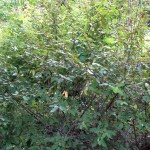by Catherine Haug, Sept 2, 2012
Photo by Catherine Haug
First I want to be clear on this point: this post is not about whether our warming trend is human caused. This post is about what we all are observing this year throughout Montana, and what we can – and should- do to avert trouble from the drought.
The last two winters, Montana was blessed with heavy snowfall in the mountains, and we all rejoiced that drought was over. Little did we guess that this summer would be one of the driest on record and that drought east of the divide would be so intense and devastating to our forests and our agricultural economy.
It’s not been as bad here in Western Montana, but yesterday, I found strong evidence of the effect of increasing drought in my own yard.
Signs of Drought in my Yard
The southernmost portion of my yard, which is mostly shaded by a hill and road embankment, is populated with naturally-seeded wild plants native to our area, including serviceberry, soapberry, thimbleberry and snowberry bushes, false Jacob’s Ladder, wild rose, Rocky Mountain Maple, hawthorne and young Douglas fir trees. (See photo from my yard, above). In fact, the only non-native plants that grow in this area are an apple tree and a small lilac shrub, and these also seeded from the wild.
Yesterday I was watering parts of my lawn that don’t get enough water from my sprinkling system, when I noticed the apple and the soapberry bush were both thirsty and wilted. This has never happened before in my memory. So I set up a sprinkler and watered each of these for 45 minutes.
But if this drought continues, we may not have the luxury of being able to irrigate our yards so lavishly; indeed, we may be hard-pressed to have enough water for drinking and bathing.
What can we do?
I don’t pretend to be the expert on this topic, but there are a few things I can recommend. See also Preparing for widespread drought (Aug 11).
- Install a storm-water collection system, to capture and store rainfall.
- Install a gray-water system to capture and store water drained from our bathtubs/showers, kitchen, bathroom & laundry sinks, and washing machines.
- Cease using toxic detergent and cleaners that can pollute our precious water and gray-water systems. For example, use real soap made by local soap makers; use distilled vinegar and peroxide instead of bleach for sterilizing surfaces.
- Utilize permaculture techniques to conserve water for irrigation and retain moistur in your soil.
- Landscape with plants native to our area, as they are conditioned for our climate. But also consider landscaping with some plants native to eastern Montana, which are conditioned to surviving drought conditions. Especially consider those with deep roots, that will hold moisture in the soil.
For more information on these topics, see:
- Gathering Summary: Rainwater Collection with Bill Brenner
- The EssentiaList: Water Conservation, Rainwater, Gray Water; Sources & Info
- Gathering Summary: Making Soap at Home, by Kathy Mansfield of Snowbunny Soap, January 26, 2011 (9 pages)
- Handcrafted Soap (Slideshow for ESP by K. Mansfield, Snowbunny Soap)
- The EssentiaList: The Basics of Soapmaking
- Home, Farm, Ranch Files under ‘Native Landscape,’ Soap and Candle-making,’ or ‘Water conservation’
